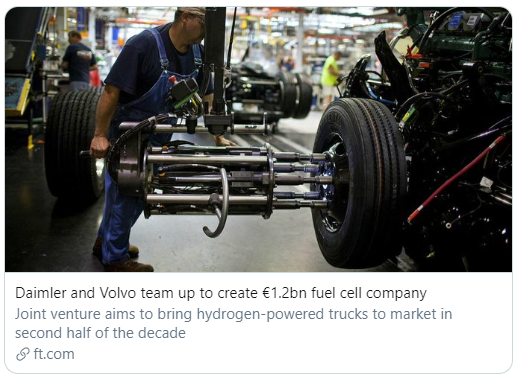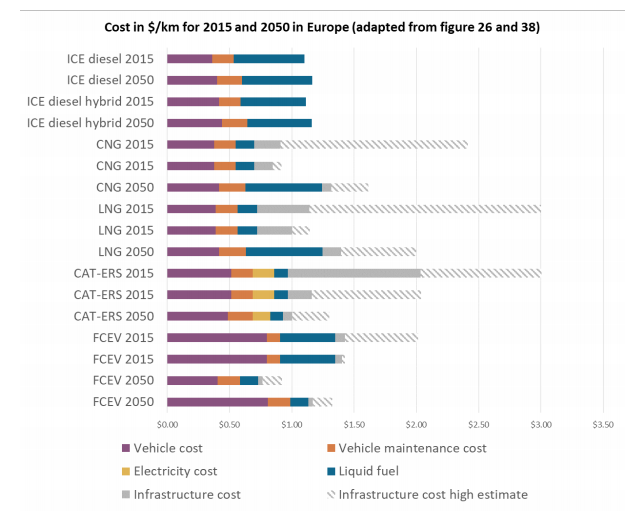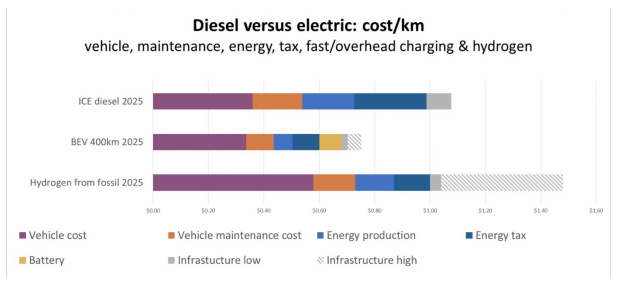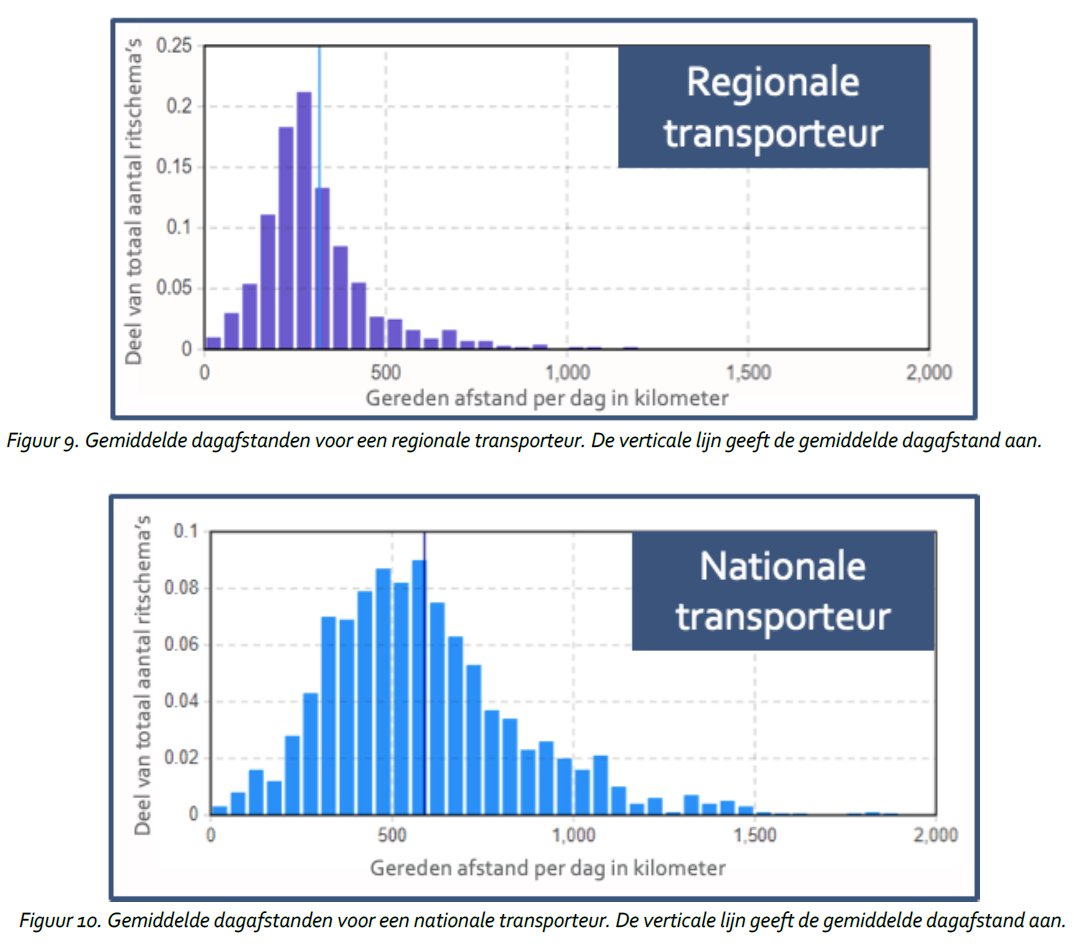In reaction to this thread of @MLiebreich (with reactions of @bryworthington) let me explain why I think eTrucks (not hydrogen, not trucks with catenary overheads) will corner most of the 40 tonnes heavy semi-trucking market and outcompete diesel.
https://twitter.com/MLiebreich/status/1253570658895872000
https://twitter.com/MLiebreich/status/1253570658895872000
In 2017 I reacted when the @IEA came out with their "the future of trucks" report two years back (update here https://www.iea.org/reports/tracking-transport-2019/trucks-and-buses) in which they left out electric trucks.
First I reverse engineered their calculations. See picture.
First I reverse engineered their calculations. See picture.
I added the scenario of an electric truck with 400 km range. I found it blew diesel and hydrogen out of the water with very little downsides. (Catenary is great too but requires international institutional cooperation: I'm not holding my breath.)
https://www.elaad.nl/news/auke-hoekstra-electric-trucks-economically-and-environmentally-desirable-but-misunderstood/
https://www.elaad.nl/news/auke-hoekstra-electric-trucks-economically-and-environmentally-desirable-but-misunderstood/
Sanjay Dinker wrote his master thesis for me on the characteristics of such a truck, using the @Tesla Semi as a background.
Among others, we determined a modern truck would need 1.3 kWh/km on average.
https://www.dropbox.com/s/6kw7yq56ucpig7c/Graduation_Thesis_Report_Sanjay_Dinker_1034870.pdf?dl=0
Among others, we determined a modern truck would need 1.3 kWh/km on average.
https://www.dropbox.com/s/6kw7yq56ucpig7c/Graduation_Thesis_Report_Sanjay_Dinker_1034870.pdf?dl=0
I also studied how companies around the Port of Rotterdam drive around. Turns out 80-90% of trucks drive 500-750 km a day and come home to their depot. Picture shows regional and national transporters. (Dutch study)
https://www.portofrotterdam.com/sites/default/files/e-trucks-elektrisch-containervervoer-vanuit-de-rotterdamse-haven.pdf
https://www.portofrotterdam.com/sites/default/files/e-trucks-elektrisch-containervervoer-vanuit-de-rotterdamse-haven.pdf
So that means a 1.3*750=975 kWh or 1 MWh battery can provide almost all trucks with the means to drive all day and charge overnight in the garage.
"Such a large battery is so heavy that it becomes impossible to take anything with you!" is what many people say. Well... not quite.
"Such a large battery is so heavy that it becomes impossible to take anything with you!" is what many people say. Well... not quite.
Let's suppose we use the cells of the current @Tesla Model 3 at 4 kg/kWh ( https://cleantechnica.com/2019/01/28/tesla-model-3-battery-pack-cell-teardown-highlights-performance-improvements/). Let's add 25% for the pack and 25% to provide an even better cycle life: 6kg/kWh.
That means the 1 MWh battery we need weights 6t (tonnes).
That means the 1 MWh battery we need weights 6t (tonnes).
Frans Verbruggen and I determined that you save a whopping 3t if you redesign your truck with electric motors close to or in the wheels.
https://www.researchgate.net/publication/332780799_Evaluation_of_the_state-of-the-art_of_full-electric_medium_and_heavy-duty_trucks
https://www.researchgate.net/publication/332780799_Evaluation_of_the_state-of-the-art_of_full-electric_medium_and_heavy-duty_trucks
And I cheered on the @transenv initiative that got zero emission trucks a and others to implement an extra weight allowance of 2 tonnes in the EU. So electric trucks in the EU can carry a 5 tonnes battery without losing cargo. Their max cargo capacity is just 1t less!
From our Port of Rotterdam statistics we could see that most trucks don't need max capacity. Don't believe me: believe this trucker: https://www.quora.com/How-much-does-the-average-big-rig-truck-weigh
So really: battery weight is not a long term problem for electric trucks and it can get you the cheapest energy/km.
So really: battery weight is not a long term problem for electric trucks and it can get you the cheapest energy/km.
This is important: 40t trucks cause the most CO2 emissions of all freight transport types.
If we electrify them we also use batteries to maximum effect because these trucks save an unparalleled amount of CO2 (and money!) per kWh of battery.
/end
If we electrify them we also use batteries to maximum effect because these trucks save an unparalleled amount of CO2 (and money!) per kWh of battery.
/end
This slide regularly pops up in my timeline now. https://twitter.com/RECESS_CA/status/1250188310518976513?s=20 Errors imho:
Not aware of the 3t (6600 lbs) drivetrain advantage.
Battery 8.5 kg/kWh instead of the 6 kg/kWh that I got by basing it on current battery tech.
Energy use 1.6 kWh/km is non-optimized truck.
Not aware of the 3t (6600 lbs) drivetrain advantage.
Battery 8.5 kg/kWh instead of the 6 kg/kWh that I got by basing it on current battery tech.
Energy use 1.6 kWh/km is non-optimized truck.
Also nice to mention: @M_Steinbuch and I have now supervised 3 master students on electric trucks. I just don't get around to writing it all up properly.
Wow, @foroelectricos just wrote an article about this thread in SPANISH. I've often thought that it would be great to write not just Dutch and English but also Spanish, French and German. So I'm really glad about this. https://forococheselectricos.com/2020/05/los-camiones-electricos-a-bateria-seran-los-encargados-de-sustituir-a-los-diesel-no-los-de-hidrogeno.html

 Read on Twitter
Read on Twitter







